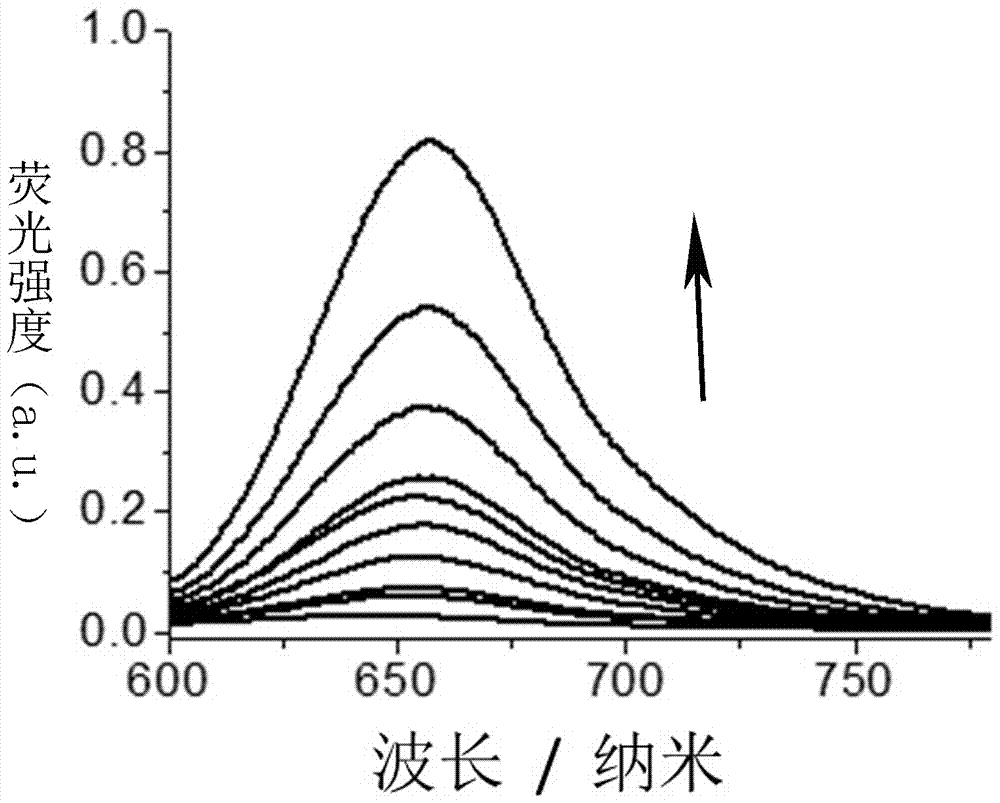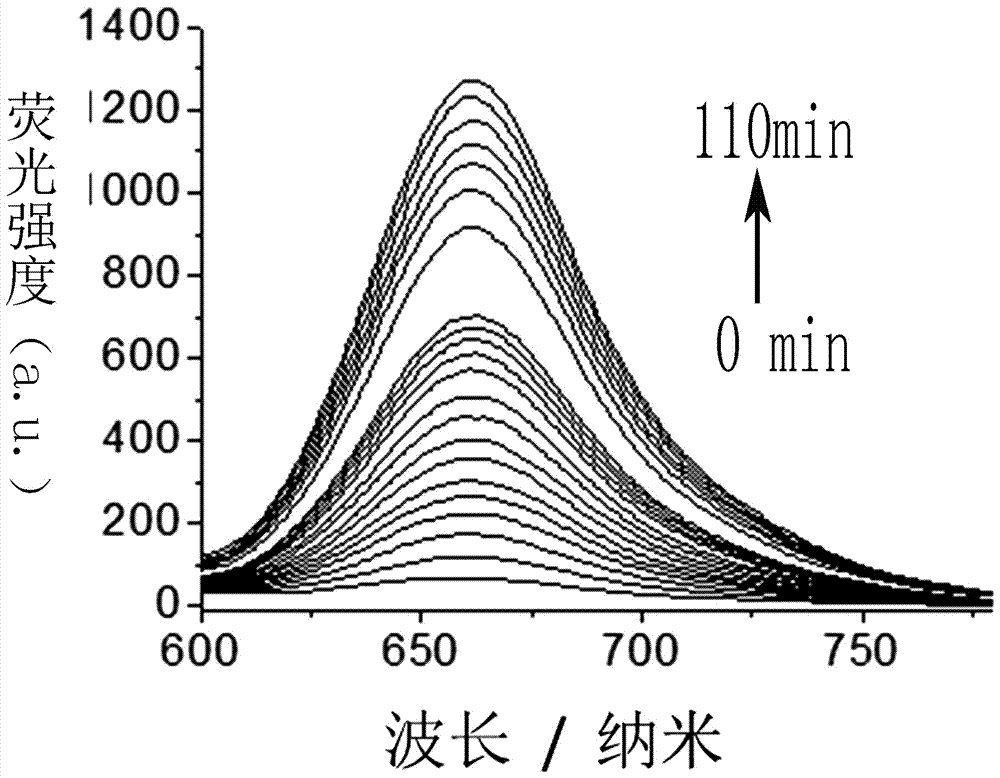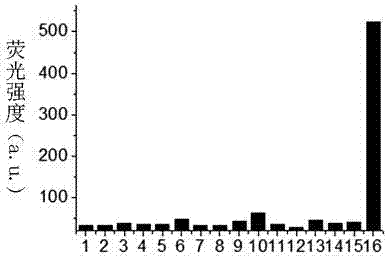Carbon monoxide detecting fluorescent probe and preparation method and application thereof
A technology of fluorescent probe and carbon monoxide, which is applied in chemical instruments and methods, fluorescence/phosphorescence, and analysis through chemical reaction of materials, etc., can solve the problems of limited application and long reaction time, and achieve high selectivity and sensitive detection High and simple preparation method
- Summary
- Abstract
- Description
- Claims
- Application Information
AI Technical Summary
Problems solved by technology
Method used
Image
Examples
Embodiment 1
[0033] A fluorescent probe for detecting carbon monoxide, the molecular formula of the probe is C 44 h 40 N 4 o 8 PD 2 , has the structure shown in formula (I):
[0034]
[0035] (I).
[0036] The name of the compound represented by formula (I) is acetoxy (9-(diethylamino)-5-oxo-5H-benzo[a]phenoxazin-1-yl)palladium, or COP for short.
[0037] A method for preparing a fluorescent probe for detecting carbon monoxide, comprising the following steps:
[0038] (1) Dissolve 9-(diethylamino)-5H-benzo[a]phenoxazin-5-one and palladium acetate in acetic acid and react at 60°C for 2 hours to obtain a blue solid;
[0039] In the step (1), the molar ratio of 9-(diethylamino)-5H-benzo[a]phenoxazin-5-one to palladium acetate is 1:1.5.
[0040] In the step (1), the dosage of acetic acid is 10 mL of acetic acid per mmol of 9-(diethylamino)-5H-benzo[a]phenoxazin-5-one.
[0041] (2) The blue solid was recrystallized from ethanol, separated and purified to obtain the compound represent...
Embodiment 2
[0047] A fluorescent probe for detecting carbon monoxide, the molecular formula of the probe is C 44 h 40 N 4 o 8 PD 2 , has the structure shown in formula (I):
[0048]
[0049] (I).
[0050] The name of the compound represented by formula (I) is acetoxy (9-(diethylamino)-5-oxo-5H-benzo[a]phenoxazin-1-yl)palladium, or COP for short.
[0051] A method for preparing a fluorescent probe for detecting carbon monoxide, comprising the following steps:
[0052] (1) Dissolve 9-(diethylamino)-5H-benzo[a]phenoxazin-5-one and palladium acetate in acetic acid, and react at 60°C for 6 hours to obtain a blue solid;
[0053] In the step (1), the molar ratio of 9-(diethylamino)-5H-benzo[a]phenoxazin-5-one to palladium acetate is 1:1.2.
[0054] In the step (1), the dosage of acetic acid is 40 mL of acetic acid per mmol of 9-(diethylamino)-5H-benzo[a]phenoxazin-5-one.
[0055] (2) The blue solid was recrystallized with ethanol, separated and purified to obtain the compound represen...
Embodiment 3
[0061] A fluorescent probe for detecting carbon monoxide, the molecular formula of the probe is C 44 h 40 N 4 o 8 PD 2 , has the structure shown in formula (I):
[0062]
[0063] (I).
[0064] The name of the compound represented by formula (I) is acetoxy (9-(diethylamino)-5-oxo-5H-benzo[a]phenoxazin-1-yl)palladium, or COP for short.
[0065] A method for preparing a fluorescent probe for detecting carbon monoxide, comprising the following steps:
[0066] (1) Dissolve 9-(diethylamino)-5H-benzo[a]phenoxazin-5-one and palladium acetate in acetic acid and react at 60°C for 10 hours to obtain a blue solid;
[0067] In the step (1), the molar ratio of 9-(diethylamino)-5H-benzo[a]phenoxazin-5-one to palladium acetate is 1:1.
[0068] In the step (1), the dosage of acetic acid is 70 mL of acetic acid per mmol of 9-(diethylamino)-5H-benzo[a]phenoxazin-5-one.
[0069] (2) The blue solid was recrystallized with ethanol, separated and purified to obtain the compound represente...
PUM
 Login to View More
Login to View More Abstract
Description
Claims
Application Information
 Login to View More
Login to View More - R&D
- Intellectual Property
- Life Sciences
- Materials
- Tech Scout
- Unparalleled Data Quality
- Higher Quality Content
- 60% Fewer Hallucinations
Browse by: Latest US Patents, China's latest patents, Technical Efficacy Thesaurus, Application Domain, Technology Topic, Popular Technical Reports.
© 2025 PatSnap. All rights reserved.Legal|Privacy policy|Modern Slavery Act Transparency Statement|Sitemap|About US| Contact US: help@patsnap.com



